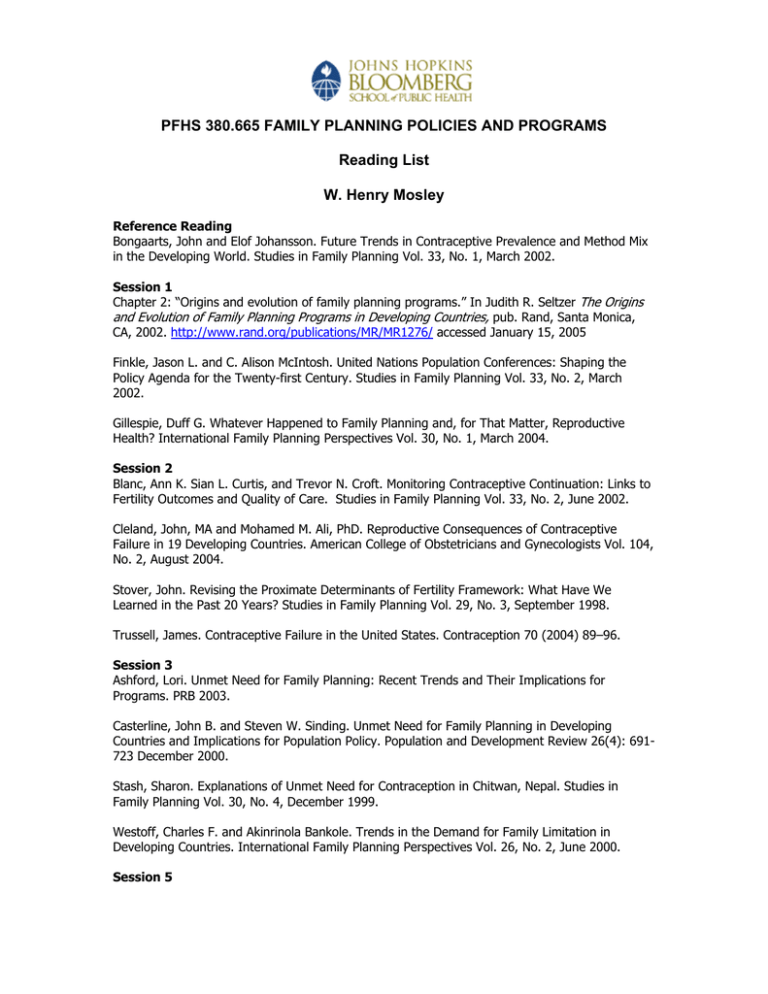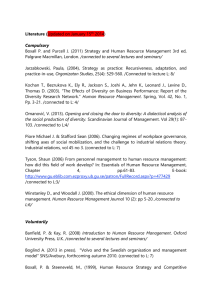
PFHS 380.665 FAMILY PLANNING POLICIES AND PROGRAMS
Reading List
W. Henry Mosley
Reference Reading
Bongaarts, John and Elof Johansson. Future Trends in Contraceptive Prevalence and Method Mix
in the Developing World. Studies in Family Planning Vol. 33, No. 1, March 2002.
Session 1
Chapter 2: “Origins and evolution of family planning programs.” In Judith R. Seltzer The Origins
and Evolution of Family Planning Programs in Developing Countries, pub. Rand, Santa Monica,
CA, 2002. http://www.rand.org/publications/MR/MR1276/ accessed January 15, 2005
Finkle, Jason L. and C. Alison McIntosh. United Nations Population Conferences: Shaping the
Policy Agenda for the Twenty-first Century. Studies in Family Planning Vol. 33, No. 2, March
2002.
Gillespie, Duff G. Whatever Happened to Family Planning and, for That Matter, Reproductive
Health? International Family Planning Perspectives Vol. 30, No. 1, March 2004.
Session 2
Blanc, Ann K. Sian L. Curtis, and Trevor N. Croft. Monitoring Contraceptive Continuation: Links to
Fertility Outcomes and Quality of Care. Studies in Family Planning Vol. 33, No. 2, June 2002.
Cleland, John, MA and Mohamed M. Ali, PhD. Reproductive Consequences of Contraceptive
Failure in 19 Developing Countries. American College of Obstetricians and Gynecologists Vol. 104,
No. 2, August 2004.
Stover, John. Revising the Proximate Determinants of Fertility Framework: What Have We
Learned in the Past 20 Years? Studies in Family Planning Vol. 29, No. 3, September 1998.
Trussell, James. Contraceptive Failure in the United States. Contraception 70 (2004) 89–96.
Session 3
Ashford, Lori. Unmet Need for Family Planning: Recent Trends and Their Implications for
Programs. PRB 2003.
Casterline, John B. and Steven W. Sinding. Unmet Need for Family Planning in Developing
Countries and Implications for Population Policy. Population and Development Review 26(4): 691723 December 2000.
Stash, Sharon. Explanations of Unmet Need for Contraception in Chitwan, Nepal. Studies in
Family Planning Vol. 30, No. 4, December 1999.
Westoff, Charles F. and Akinrinola Bankole. Trends in the Demand for Family Limitation in
Developing Countries. International Family Planning Perspectives Vol. 26, No. 2, June 2000.
Session 5
Greenhalgh, Susan. Science, Modernity, and the Making of China’s One-Child Policy. Population
and Development Review 29(2):163-196 June 2003.
Hoodfar, Homa and Samad Assadpour. The Politics of Population Policy in the Islamic Republic of
Iran. Studies in Family Planning Vol. 31, No. 1, March 2003.
Session 6
Bongaarts, John. Trends in Unwanted Childbearing in the Developing World. Studies in Family
Planning, Volume 28, Issue 4 (Dec., 1997), 267-277.
Junhong, Chu. Prenatal Sex Determination and Sex-Selective Abortion in Rural Central China.
Population and Development Review 27(2):259-281 (June 2001).
Marston, Cicely and John Cleland. Relationships Between Contraception and Abortion: A Review
of the Evidence. International Family Planning Perspectives Vol. 29, No. 1, March 2003.
Session 7
Diaz, Margarita, Ruth Simmons, Juan Diaz, Carlos Gonzalez, Maria Yolanda Makuch, and Debora
Bossemeyer. Expanding Contraceptive Choice: Findings from Brazil. Studies in Family Planning
30[1]: 1-16.
Goldberg, Howard L. and Aykut Toros. The Use of Traditional Methods of Contraception among
Turkish Couples. Studies in Family Planning, Vol. 25, No. 2, 122-128, March-April 1994.
Padmadas, Sabu S., Inge Hutter, and Frans Willekens. Compression of Women’s Reproductive
Spans in Andrha Pradesh, India. International Family Planning Perspectives, 2004, 30(1):12–19
Rajaretnam, T. and R. V. Deshpande. Factors Inhibiting the use of Reversible Contraceptive
Methods in Rural South India. Studies in Family Planning Vol. 25, No. 2, 111-121, March-April
1994.
RamaRao, Saumya and Raji Mohanam. The Quality of Family Planning Programs: Concepts,
Measurements, Interventions, and Effects. Studies in Family Planning 2003; 34[4]: 227-248.
Saavala, Minna. Understanding the Prevalence of Female Sterilizatio in Rural South India. Studies
in Family Planning Vol. 30, No. 4, December 1999.
Schuler, Sidney Ruth, Maria Eugenia Choque, and Susanna Rance. Misinformation, Mistrust, and
Mistreatment: Family Planning among Bolivian Market Women. Studies in Family Planning, Vol.
25, No. 4, 211-221 (July-August, 1994).
Simmons, Ruth, Joseph Brown, and Margarita Diaz. Facilitating Large-scale Transitions to Quality
of Care: An idea Whose Time Has Come. Studies in Family Planning 2002; 33(1):61-75, March
2002.
Solo, Julie, Deborah L. Billings, Collette Aloo-Obunga, Achola Ominde, and Margaret Makumi.
Creating Linkages Between Incomplete Abortion Treatment and Family Planning Services in
Kenya. Studies in Family Planning 1999; 30[1]: 17-27.
Speizer, Ilene S., David R. Hotchkiss, Robert J. Magnani, Brian Hubbard, and Kristen Nelson. Do
Service Providers in Tanzania Unnecessarily Restrict Clients’ Access to Contraceptive Methods?
International Family Planning Perspectives, 20002, 26(1):13-20 & 42.
Tuoane, Maletela, Nyovani Janet Madise, and Ian Diamond. Provision of Family Planning Services
in Lesotho. International Family Planning Perspectives, 30(2):77-86.
Session 8
Haws, Jeanne, Lynn Bakamjian, Tim Williams, and Karen Johnson Lassner. Impact of
Sustainability Policies on Sterilization Services in Latin America. Studies in Family Planning, Vol.
23, No. 2, 85-96. March-April 1992.
Janowitz, Barbara and John H. Bratt. Costs of Family Planning Services: A Critique of the
Literature. International Family Planning Perspectives, Vol. 18, No., 4, 137-144, December 1992.
Matheny, Gaverick. Family Planning Programs: Getting the Most for the Money. International
Family Planning Perspectives Vol. 30, No. 3, September 2004.
Meekers, Dominique and Stephen Rahaim. The Importance of Socio-Economic Context for Social
Marketing Models for Improving Reproductive Health: Evidence from 555 Years of Program
Experience. BMC Public Health 2005, 5:10. This article is available from:
http://www.biomedcentral.com/1471-2458/5/10.
Ross, John A. and Stephen L. Isaacs. Costs, Payments, and Incentives in Family Planning
Programs: A Review for Developing Countries. Studies in Family Planning, Vol. 19, No. 5, 270283, Sept.-Oct. 1988.
Schuler, Sidney Ruth, Lisa Bates, and Md. Khairul Islam. Reconciling Cost Recovery with Health
Equity Concerns in a Context of Gender Inequality and Poverty: Findings from a New Family
Health Initiative in Bangladesh. International Family Planning Perspectives, 28(4)196-204.
Session 9
Cleland, John and W. Parker Mauldin. The Promotion of Family Planning by Financial Payments:
The Case of Bangladesh. Studies in Family Planning, Vol. 22, No. 1 (Jan.-Feb., 1991), 1-18.
Freedman, Lynn P. and Stephen L. Isaacs. Human Rights and Reproductive Choice. Studies in
Family Planning, Vol. 24, No. 1 (Jan. – Feb., 1993), 18-30.
Isaacs, Stephen L. Incentives, Population Policy, and Reproductive Rights: Ethical Issues. Studies
in Family Planning, Vol. 26, No. 6 (Nov.-Dec., 1995), 363-367.
Ping, Tu and Herbert L. Smith. Determinants of Induced Abortion and Their Policy Implications in
Four Countries in North China. Studies in Family Planning, Vol. 26, No. 5 (Sept. – Oct., 1995),
278-286.
Short, Susan E. and Zhai Fengying. Looking Locally at China’s One-Child Policy. Studies in Family
Planning, Vol. 29, No. 4 (Dec. 1998), 373-387.
Session 10
Bawah, Ayaga Agula, Patricia Akweongo, Ruth Simmons, and James F. Phillips. Women’s Fears
and Men’s Anxieties: The Impact of Family Planning on Gender Relations in Northern Ghana.
Studies in Family Planning, Vol. 30, No. 1 (March 1999), 54-66.
Biddlecom, Ann E. and Bolaji M. Fapohunda. Covert Contraceptive Use: Prevalence, Motivations,
and Consequences. Studies in Family Planning, Vol. 29, No. 4 (Dec. 1998), 360-372.
Blanc, Ann K. The Effect of Power in Sexual Relationships on Sexual and Reproductive Health: An
Examination of the Evidence. Studies in Family Planning Vol. 32 No. 3 (Sept. 2001).
Pallitto, Christina C. and Patricia O’Campo. The Relationship Between Intimate Partner Violence
and Unintended Pregnancy: Analysis of a National Sample from Colombia. International Family
Planning Perspectives, 2004, 30(4):165-173.
Ratcliffe, Amy A., Allan G. Hill, and Gijs Walraven. Separate Lives, Different Interests: Male and
Female Reproduction in the Gambia. Bulletin of the World Health Organization, 2000, 78(5).
Session 12
Dehne, K. L, R. Snow, and K. R. O’Reilly. Integration of Prevention and Care of Sexually
Transmitted Infections with Family Planning Services: What is the Evidence for Public Health
Benefits? Bulletin of the World Health Organization, 2000, 78(5).
Helzner, Judith F. Transforming Family Planning Services in the Latin American and Caribbean
Region. Studies in Family Planning Vol. 33, No. 1, March 2002.
Lush, Louisiana. Service Integration: An Overview of Policy Developments. International Family
Planning Perspectives Vol. 28, No. 2, June 2002.
Phillips, James F., Wendy L. Greene, and Elizabeth F. Jackson. Lessons from Community-based
Distribution of Family Planning in Africa. 1999.
Routh, Subrata, Ali Ashraf, John Stoeckel, and Barkat-e-Khuda. Consequences of the Shift from
Domiciliary Distribution to Site-Based Family Planning Services in Bangladesh. International
Family Planning Perspectives Vol. 27, No. 2, June 2001.
Shelton, James D., Lois Bradshaw, Babar Hussein, Zeba Zubair, Tony Drexler, and Mark Reade
McKenna. Putting Unmet Need to the Test: Community-Based Distribution of Family Planning in
Pakistan. International Family Planning Perspectives Vol. 25, No. 4, December 1999.
Stewart, John F., Guy Stecklov, and Alfred Adewuyi. Family Planning Program Structure and
Performance in West Africa. International Family Planning Perspectives Vol. 25, Supplement,
1999.
Copyright 2005, The Johns Hopkins University and Henry Mosley. All rights reserved. Use of these materials permitted only in accordance with license rights
granted. Materials provided “AS IS”; no representations or warranties provided. User assumes all responsibility for use, and all liability related thereto, and must
independently review all materials for accuracy and efficacy. May contain materials owned by others. User is responsible for obtaining permissions for use from
third parties as needed.






